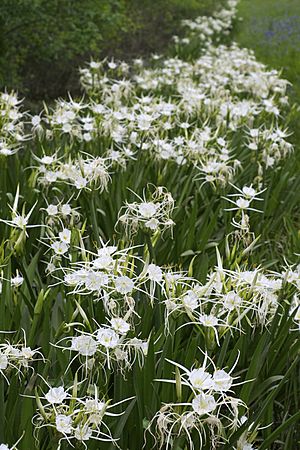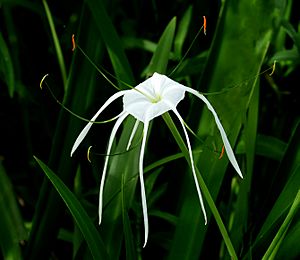Texas spider-lily facts for kids
Quick facts for kids Texas spider-lily |
|
|---|---|
 |
|
| Scientific classification | |
| Synonyms | |
|
Hymenocallis liriosme is a beautiful plant from North America. It grows from a special underground part called a bulb, much like an onion. This plant is found in several states, including Texas, Louisiana, Oklahoma, Arkansas, Mississippi, and Alabama.
This unique plant loves wet places. You can often spot it growing in ditches, along the edges of marshes, and near swamps and ponds. It has several common names, like Texas spider-lily and Louisiana marsh spider-lily. People also call it the western marsh spider-lily or spring spiderlily. One special feature of this flower is its bright yellow-green center, which looks like an "eye" in the middle of its petals.
Contents
What is the Texas Spider-Lily?
The Texas spider-lily, or Hymenocallis liriosme, is a type of flowering plant. It belongs to the Amaryllis family, which includes many other beautiful flowers like daffodils. These plants are known for their striking, often white, flowers that have long, slender petals.
How Does This Plant Look?
The Hymenocallis liriosme has long, strap-like leaves that are green and shiny. Its flowers are usually white and have a unique shape. They have six long, narrow petals that spread out, making them look a bit like spider legs. In the center of the flower, there's a cup-shaped part called a corona. This corona is what gives the flower its distinctive yellow-green "eye."
What Makes the Flower Special?
The corona is a key feature of spider-lilies. It's like a small crown inside the flower. For Hymenocallis liriosme, this corona is a bright yellow-green color. This makes it easy to tell apart from other similar plants. The flowers usually bloom in the spring, bringing a splash of white to their marshy homes.
Where Does the Spider-Lily Grow?
This plant is native to the southeastern United States. It thrives in warm, humid climates. Its natural habitat includes areas with plenty of water. This is why you find it in wetlands, like marshes and swamps.
What Kind of Habitat Does it Prefer?
Hymenocallis liriosme is a true water-loving plant. It needs moist or wet soil to grow well. It can even tolerate periods when its roots are underwater. This makes it perfectly suited for its home in ditches and along the edges of ponds.
Life Cycle of the Spider-Lily
Like many plants, the Texas spider-lily goes through different stages in its life. It starts as a bulb underground. This bulb stores energy, helping the plant survive through drier periods.
How Does it Reproduce?
The plant produces seeds after its flowers are pollinated. These seeds can then grow into new plants. The bulbs can also divide, creating new plants from the original one. This helps the spider-lily spread and create new groups of plants in its habitat.
When Does it Bloom?
The flowers typically appear in the spring. This is why one of its common names is "spring spiderlily." The blooming period can vary slightly depending on the exact location and weather conditions. After blooming, the plant focuses on producing seeds and storing energy in its bulb for the next year.
Why is This Plant Important?
Hymenocallis liriosme plays a role in its ecosystem. It provides beauty to its natural surroundings. It also contributes to the biodiversity of the wetlands where it grows.
What is Biodiversity?
Biodiversity means the variety of life in a particular habitat or on Earth. Having many different kinds of plants and animals makes an ecosystem strong and healthy. The spider-lily is one small but important part of this natural variety.
Can People Plant Them?
Yes, people sometimes plant Hymenocallis liriosme in gardens. They are popular in water gardens or bog gardens because they love wet conditions. Their unique flowers add a touch of wild beauty to cultivated spaces.


